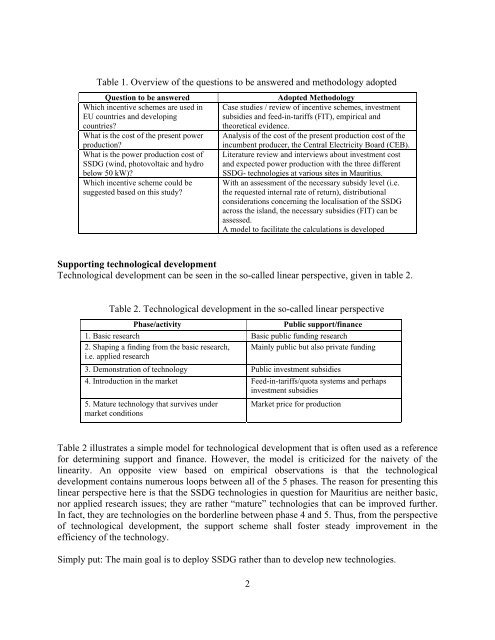Mauritius - a sustainable island - Ea Energianalyse
Mauritius - a sustainable island - Ea Energianalyse
Mauritius - a sustainable island - Ea Energianalyse
You also want an ePaper? Increase the reach of your titles
YUMPU automatically turns print PDFs into web optimized ePapers that Google loves.
Table 1. Overview of the questions to be answered and methodology adopted<br />
Question to be answered<br />
Which incentive schemes are used in<br />
EU countries and developing<br />
countries<br />
What is the cost of the present power<br />
production<br />
What is the power production cost of<br />
SSDG (wind, photovoltaic and hydro<br />
below 50 kW)<br />
Which incentive scheme could be<br />
suggested based on this study<br />
Adopted Methodology<br />
Case studies / review of incentive schemes, investment<br />
subsidies and feed-in-tariffs (FIT), empirical and<br />
theoretical evidence.<br />
Analysis of the cost of the present production cost of the<br />
incumbent producer, the Central Electricity Board (CEB).<br />
Literature review and interviews about investment cost<br />
and expected power production with the three different<br />
SSDG- technologies at various sites in <strong>Mauritius</strong>.<br />
With an assessment of the necessary subsidy level (i.e.<br />
the requested internal rate of return), distributional<br />
considerations concerning the localisation of the SSDG<br />
across the <strong>island</strong>, the necessary subsidies (FIT) can be<br />
assessed.<br />
A model to facilitate the calculations is developed<br />
Supporting technological development<br />
Technological development can be seen in the so-called linear perspective, given in table 2.<br />
Table 2. Technological development in the so-called linear perspective<br />
Phase/activity<br />
Public support/finance<br />
1. Basic research Basic public funding research<br />
2. Shaping a finding from the basic research, Mainly public but also private funding<br />
i.e. applied research<br />
3. Demonstration of technology Public investment subsidies<br />
4. Introduction in the market Feed-in-tariffs/quota systems and perhaps<br />
investment subsidies<br />
5. Mature technology that survives under<br />
market conditions<br />
Market price for production<br />
Table 2 illustrates a simple model for technological development that is often used as a reference<br />
for determining support and finance. However, the model is criticized for the naivety of the<br />
linearity. An opposite view based on empirical observations is that the technological<br />
development contains numerous loops between all of the 5 phases. The reason for presenting this<br />
linear perspective here is that the SSDG technologies in question for <strong>Mauritius</strong> are neither basic,<br />
nor applied research issues; they are rather “mature” technologies that can be improved further.<br />
In fact, they are technologies on the borderline between phase 4 and 5. Thus, from the perspective<br />
of technological development, the support scheme shall foster steady improvement in the<br />
efficiency of the technology.<br />
Simply put: The main goal is to deploy SSDG rather than to develop new technologies.<br />
2
















